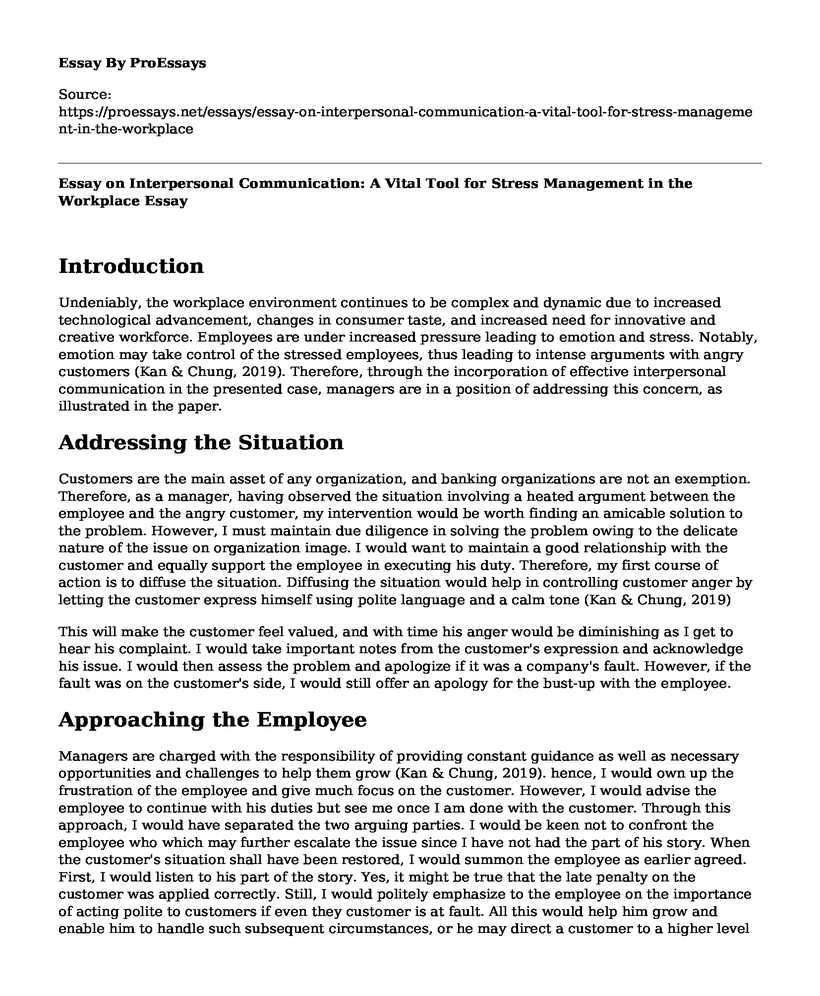Introduction
Undeniably, the workplace environment continues to be complex and dynamic due to increased technological advancement, changes in consumer taste, and increased need for innovative and creative workforce. Employees are under increased pressure leading to emotion and stress. Notably, emotion may take control of the stressed employees, thus leading to intense arguments with angry customers (Kan & Chung, 2019). Therefore, through the incorporation of effective interpersonal communication in the presented case, managers are in a position of addressing this concern, as illustrated in the paper.
Addressing the Situation
Customers are the main asset of any organization, and banking organizations are not an exemption. Therefore, as a manager, having observed the situation involving a heated argument between the employee and the angry customer, my intervention would be worth finding an amicable solution to the problem. However, I must maintain due diligence in solving the problem owing to the delicate nature of the issue on organization image. I would want to maintain a good relationship with the customer and equally support the employee in executing his duty. Therefore, my first course of action is to diffuse the situation. Diffusing the situation would help in controlling customer anger by letting the customer express himself using polite language and a calm tone (Kan & Chung, 2019)
This will make the customer feel valued, and with time his anger would be diminishing as I get to hear his complaint. I would take important notes from the customer's expression and acknowledge his issue. I would then assess the problem and apologize if it was a company's fault. However, if the fault was on the customer's side, I would still offer an apology for the bust-up with the employee.
Approaching the Employee
Managers are charged with the responsibility of providing constant guidance as well as necessary opportunities and challenges to help them grow (Kan & Chung, 2019). hence, I would own up the frustration of the employee and give much focus on the customer. However, I would advise the employee to continue with his duties but see me once I am done with the customer. Through this approach, I would have separated the two arguing parties. I would be keen not to confront the employee who which may further escalate the issue since I have not had the part of his story. When the customer's situation shall have been restored, I would summon the employee as earlier agreed. First, I would listen to his part of the story. Yes, it might be true that the late penalty on the customer was applied correctly. Still, I would politely emphasize to the employee on the importance of acting polite to customers if even they customer is at fault. All this would help him grow and enable him to handle such subsequent circumstances, or he may direct a customer to a higher level of management or employee who he feels can assist the customer.
How to Satisfy the Situation with the Angry Customer
I would be keen to avoid the customer dragging me back into the emotional argument by using such polite phrases, including "your situation is frustrating, and I understand, but can we try and fix it?" (Kan & Chung, 2019) In the process, I would have contained the customer. I will keep calm and not take anything personally to help me focus on facts and control my emotions as well. Notably, to satisfy the situation completely, I would employ the following steps. I will reassure the customer that I have listened to the problem; I would show signs of empathy on his situation, keep the situation real, and finally offer a solution. In offering a solution, I would acquit the customer with company terms, and conditions on penalties and later ask the customer what he feels. Even if the penalty was applied correctness, he would now feel appreciated and valued and would instead accept the fact and avoid a repeat of such a penalty.
Reference
Kan, S., Chung, D., & Chung, G. (2019). Customer Experience Transformation in the Aviation Industry: Business Strategy Realization through Design Thinking, Innovation Management, and HPT. Performance Improvement, 58(1), 13-30.
Cite this page
Essay on Interpersonal Communication: A Vital Tool for Stress Management in the Workplace. (2023, Jul 02). Retrieved from https://proessays.net/essays/essay-on-interpersonal-communication-a-vital-tool-for-stress-management-in-the-workplace
If you are the original author of this essay and no longer wish to have it published on the ProEssays website, please click below to request its removal:
- African American Perceptions on the Use of Condoms Essay
- Exploring the Barriers: Studies in Race, Class, and Gender Paper Example
- Black Power Movement Essay Example
- The Basis of Divorce in England and Wales - Essay Sample
- Social Support: Understanding Instrumental, Appraisal, Emotional, and Informational Support
- Essay Sample on Streetcar Dilemma: A Classic Ethical Dilemma
- Essay Sample on Post-WWII Consumer Revolution: US Societal Change







